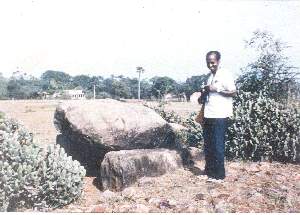Tens of thousands of years ago early man wandered all over Chingleput district area hunting, fishing and
gathering fruits. He used rough stone implements called hand-axes without any wooden handles and lived near river banks. The largest collection of Old Stone Age implements have been made for over a hundred years at Pallavaram, Poondy and Attirambakkam and recently students at Tambaram have picked up stone age tools.
Over the period of years the technique of making stone implements improved when man settled down in small groups, planted
ragi and kollu and started making pottery. Even as late as 1500 B.C. man depended on stone tools
-- though well-made and polished. During this New Stone Age period there was a certain amount of racial mixture. Even today we use stone implements for grinding
masala and these stones resemble the ones used by the stone age people.
Around 900 B.C. iron was discovered and large-scale smelting operations were carried out all over Chingleput district. It was probably the
Kurumbas who were responsible for this innovation and our district has over 200 Iron Age sites. In these sites are
found funeral monuments of two kinds. One is the 'stone circle', a circle of about 6 metres diameter made up of boulders each of which has a diameter of less than a metre. The other is a dolmen made up of large slabs of semi-dressed stone supported by several rough stones. Very often a dolmen is erected at the centre of a stone circle. The dolmens and stone circles are called megalithic monuments or megaliths (large stones). It was this race of magalithic men who introduced paddy cultivation and built several lakes. Wherever there is a hill overlooking a lake in this district, one should look out for iron age monuments.
Chingleput region, the Kurumba-bhoomi came to be called
Thondaimandalam after the jungle was cleared of the fierce warrior tribes but it is not quite clear when this change took place. Nor is it clear whether
Thondaimandalam was a part of the Asokan empire or whether it was ruled by the
Cholas in the first century A. D. Descriptions of Kancheepuram and a port of
Thondainadu are found in the sangam classic Perumbaanaatrupadai. Excavations at Kancheepuram have established that there was thriving trade with the Romans and this was a flourishing country.
Tamil inscriptions written in a script resembling Asoka's
Brahmi script were deciphered for the first time five years ago and this outstanding achievement placed the earliest Tamil inscriptions in the second century B.C. Similar inscriptions written a few centuries after Christ were discovered at Maamandur near Kancheepuram. This period can be studied with the help of a few copper
plate inscriptions that are available.
After a brief period under the Kalabrahs, this region made great strides during the rule of the Pallavas who came into prominence at the end of the sixth century A.D. It was the
most glorious period for Kancheepuram and Maarnallapuram. Granite was used for the first time to erect large temples and these early buildings can be seen at Kancheepuram and
Maamallapuram, which was then called
Kadal Mallai. The Pallava navy was stationed at Maamallapuram and soldiers were sent to Ceylon to assist a friendly king. The great days of the Pallavas can be visualized in the quality of sculpture and painting that have survived these centuries. The only Tamil work of this period is
Nandi kalambakam composed in honour of Nandi Varrnan.
During the ninth century the Cholas came into power and continued the temple-building activity of the Pallavas. As in the days of the Pallavas new lakes were constructed and sluices were built. We hear of
Jala yantras being used for getting water for irrigation. Maamallapuram continued to be a port but became less important. The vessels of the
Cholas went to Ceylon, the Far East and China where a Tamil inscription was discovered recently. The river
Paalaar which was flowing north of Kancheepuram and North of Madras area changed its course to its present course south of Kancheepuram. Villages had local committees or
sabhai which were chosen by a form of lottery system (kudavolai) and each member had to know the Vedas.
During the fourteenth century there were two invasions by Muslim armies which went down south as far as Madurai. During this period the Pandyas and the Cheras were the big powers in the south. From the fifteenth century the
Vijayanagar kings controlled the area around Chingleput and they added new towers to the existing famous temples. Some of these unfinished
gopurams can be seen at Mahabalipuram and Tiruvanmaiyur. The hundred pillared
mandapas built during this period are of exquisite workmanship.
From the seventeenth century onwards the European powers like the Dutch, the Portuguese, the French and the British came into prominence. Every war and conflict in Europe was reflected here. The town of Chingleput which derives its name from
Chengazhuneer (red water lily) was the scene of constant fighting. The district was obtained
as a jaghir by the East India Company from the Nawab of Arcot in 1760 but was plundered more than once by the troops of Hyder
Ali of Mysore. At the beginning of the nineteenth century the Pulicat area was added to the district and from 1870 the
collectorate of Madras has been a separate administrative unit. The merger of Tirutani taluk with the district was accomplished after the recent
reorganization of States. With the renewal of interest in the history and development of the district, many government offices that were located at Saidapet are being shifted to Kancheepuram the new district headquarters. The Chingleput district area can be proud of its history and one hopes that with the determined effort of the people the future will be more glorious than the past.

Home |
Biodata |
Biography |
Photo Gallery |
Publications |
Tributes



